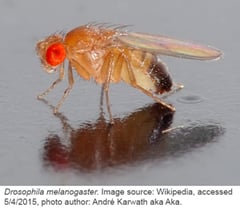 Cre-lox recombination is an incredibly useful molecular biology tool, but like any biological system, it has certain drawbacks. First, the efficiency of Cre recombination varies for different constructs and cell types. Second, Cre may induce recombination at pseudo- or cryptic loxP sites (estimated to occur at a frequency of 1.2 per megabase in mammals), leading to DNA damage and developmental aberrations. In multiple systems, Cre itself, without the presence of a floxed construct, may produce a phenotype. This problem is especially stark in Drosophila, where expression of Cre from the standard UAS/GAL4 system is toxic to proliferating cells. A Cre-estrogen receptor ligand binding domain-fusion can prevent this toxicity, but with the caveat of partial rather than complete recombination. If you’re looking to use site-specific recombination in Drosophila, read on to learn about new recombinases suitable for this system.
Cre-lox recombination is an incredibly useful molecular biology tool, but like any biological system, it has certain drawbacks. First, the efficiency of Cre recombination varies for different constructs and cell types. Second, Cre may induce recombination at pseudo- or cryptic loxP sites (estimated to occur at a frequency of 1.2 per megabase in mammals), leading to DNA damage and developmental aberrations. In multiple systems, Cre itself, without the presence of a floxed construct, may produce a phenotype. This problem is especially stark in Drosophila, where expression of Cre from the standard UAS/GAL4 system is toxic to proliferating cells. A Cre-estrogen receptor ligand binding domain-fusion can prevent this toxicity, but with the caveat of partial rather than complete recombination. If you’re looking to use site-specific recombination in Drosophila, read on to learn about new recombinases suitable for this system.
Gerald Rubin’s lab sought to make complex genome modifications in Drosophila using multiple recombinases. To make multiple, precise genome edits, the recombinases used must have high activity and specificity with low cross-reactivity, as well as low toxicity. FLP/FRT recombinases (from Saccharomyces cerevisiae) had been used successfully in Drosophila, so Rubin sought to test the suitability of four additional yeast recombinases: KD (from Kluyveromyces drosophilarum), R (from Zygosaccharomyces rouxii), B2 (from Zygosaccharomyces bailii) and B3 (from Zygosaccharomyces bisporus.)
Reporter constructs equivalent to site-STOP-site-myrRFP, with “site” representing the specific recombination site for each enzyme, were generated to test recombination efficiency. When expressed in neuronal cells, each line showed broad recombinase-dependent RFP expression. Even at low expression levels, recombination by KD, B2 and B3 resulted in complete or near-complete excision of the stop sequence. In contrast, Dre recombinase, the close relative of Cre, displayed an excision efficiency of only 70%.
To determine the cross-reactivity of these recombinases, each recombinase and reporter construct pair were tested for excision efficiency. B2 and R showed partial cross-reactivity; however, the other recombinase/reporter pairs were inactive, even at very high recombinase levels. These data show that multiple recombinases can be used together to designate specific patterns of recombination.
Finally, Rubin’s group assayed the potential toxicity of these recombinases by crossing flies homozygous for a UAS-driven recombinase with flies heterozygous for tubulin-GAL4. For Dre, Flp, KD, R, B2 and B3, approximately 50% of offspring carried both the recombinase and GAL4, indicating that the recombinases were inherited normally and thus nontoxic. In contrast, 0/79 offspring carried both Cre and GAL4, further emphasizing the toxicity of this enzyme in Drosophila.
If you're still reading this post and you don't work in Drosophila, you may be interested to know that Rubin's team found that two of these recombinases were also active in mammalian cells. In experiments, B3 and KD were shown to be functional in cultured Chinese hamster ovary (CHO) cells, as well as in cortical neurons in layer 2/3 of the mouse brain.
Rubin’s work shows that the yeast recombinases KD, B2, B3 and FLP can be used together in Drosophila as a toolkit for specific recombination patterns that require multiple recombinases. These tools should further enhance genome editing capabilities in Drosophila.
References:
Multiple new site-specific recombinases for use in manipulating animal genomes. Nern A, Pfeiffer BD, Svoboda K, Rubin GM. Proc Natl Acad Sci USA. 2011 Aug 23;108(34):14198-203. doi: 10.1073/pnas.1111704108. Epub 2011 Aug 9. PubMed.
Find the Plasmids @Addgene:
For more information about limitations and caveats of Cre usage:
Vagaries of conditional gene targeting. Schmidt-Supprian M, Rajewsky K. Nat Immunol. 2007 Jul;8(7):665-8. doi:10.1038/ni0707-665. PubMed.
Growth inhibition and DNA damage induced by Cre recombinase in mammalian cells. Loonstra A, Voojis M, Beverloo HB, Al Allak B, van Drunen E, Kanaar R, Berns A, Jonkers J. Proc Natl Acad Sci USA. 2001 Jul 31; 98(16): 9209–9214. doi:10.1073/pnas.161269798. PubMed.
Reduction of Cre recombinase toxicity in proliferating Drosophila cells by estrogen-dependent activity regulation. Heidmann D, Lehner CF. Dev Genes Evol. 2001 Sep;211(8-9):458-65. doi:10.1007/s004270100167. PubMed.
Cryptic loxP sites in mammalian genomes: genome-wide distribution and relevance for the efficiency of BAC/PAC recombineering techniques. Semprini S, Troup TJ, Kotelevtseva N, King K, Davis JR, Mullins LJ, Chapman KE, Dunbar DR, Mullins JJ. Nucleic Acids Res. 2007;35(5):1402-10. doi:10.1093/nar/gkl1108. Epub 2007 Feb 6. PubMed.
Topics: Cre-lox, Drosophila, Plasmids






Leave a Comment